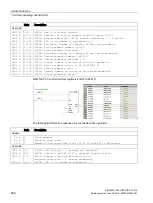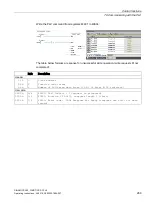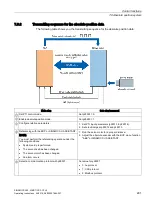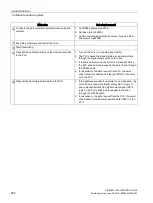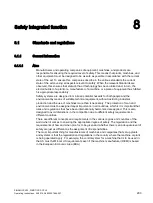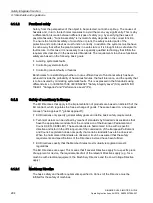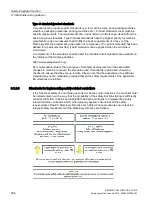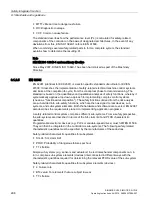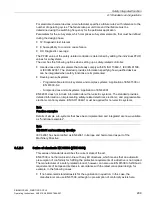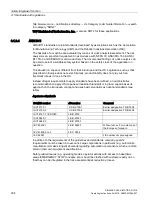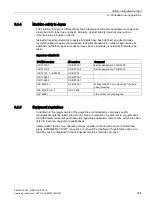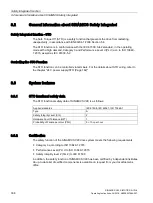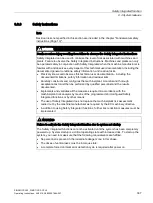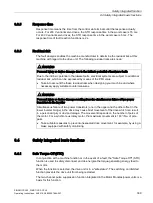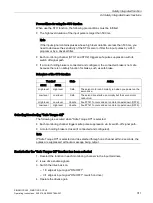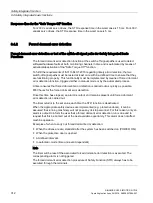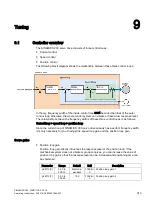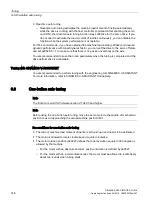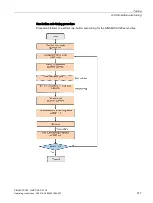
Safety Integrated function
8.1 Standards and regulations
SINAMICS V90, SIMOTICS S-1FL6
302
Operating Instructions, 04/2019, A5E36037884-007
1050). Annex A of the standard describes a method for determining the required Safety
Integrity Level (SIL).
Regardless of which standard is applied, steps must be taken to ensure that all the machine
controller components required for executing the safety-related functions fulfill these
requirements.
8.1.2.9
Residual risk
In today's technologically advanced world, the concept of safety is relative. The ability to
ensure safety to the extent that risk is ruled out in all circumstances – "zero-risk guarantee" –
is practically impossible. The residual risk is the risk that remains once all the relevant
protective measures have been implemented in accordance with the latest state of the art.
Residual risks must be clearly referred to in the machine/plant documentation (user
information according to EN ISO 12100-2).
8.1.3
Machine safety in the USA
A key difference between the USA and Europe in the legal requirements regarding safety at
work is that, in the USA, no legislation exists regarding machinery safety that is applicable in
all of the states and that defines the responsibility of the manufacturer/supplier. A general
requirement exists stating that employers must ensure a safe workplace.
8.1.3.1
Minimum requirements of the OSHA
The Occupational Safety and Health Act (OSHA) from 1970 regulates the requirement that
employers must offer a safe place of work. The core requirements of OSHA are specified in
Section 5 "Duties".
The requirements of the OSH Act are managed by the "Occupational Safety and Health
Administration" (also known as OSHA). OSHA employs regional inspectors who check
whether or not workplaces comply with the applicable regulations.
The OSHA regulations are described in OSHA 29 CFR 1910.xxx ("OSHA Regulations (29
CFR) PART 1910 Occupational Safety and Health"). (CFR: Code of Federal Regulations.)
http://www.osha.gov
The application of standards is regulated in 29 CFR 1910.5 "Applicability of standards". The
concept is similar to that used in Europe. Product-specific standards have priority over
general standards insofar as they cover the relevant aspects. Once the standards are
fulfilled, employers can assume that they have fulfilled the core requirements of the OSH Act
with respect to the aspects covered by the standards.
In conjunction with certain applications, OSHA requires that all electrical equipment and
devices that are used to protect workers be authorized by an OSHA-certified, "Nationally
Recognized Testing Laboratory" (NRTL) for the specific application.
In addition to the OSHA regulations, the current standards defined by organizations such as
NFPA and ANSI must be carefully observed and the extensive product liability legislation
that exists in the US taken into account. Due to the product liability legislation, it is in the
interests of manufacturing and operating companies that they carefully maintain the
Содержание SIMOTICS S-1FL6
Страница 1: ...SINAMICS V90 SIMOTICS S 1FL6 ...
Страница 2: ......
Страница 87: ...Mounting 3 1 Mounting the drive SINAMICS V90 SIMOTICS S 1FL6 Operating Instructions 04 2019 A5E36037884 007 85 ...
Страница 89: ...Mounting 3 1 Mounting the drive SINAMICS V90 SIMOTICS S 1FL6 Operating Instructions 04 2019 A5E36037884 007 87 ...
Страница 342: ...Tuning 9 9 PI P switching SINAMICS V90 SIMOTICS S 1FL6 340 Operating Instructions 04 2019 A5E36037884 007 ...
Страница 384: ...Parameters 10 2 Parameter list SINAMICS V90 SIMOTICS S 1FL6 382 Operating Instructions 04 2019 A5E36037884 007 ...
Страница 432: ......

